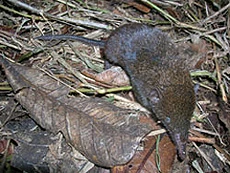If you cannot find the answer you are looking for, please contact us.
Naked-nosed shrew tenrec

First described in 1996 by Jenkins, Goodman & Raxworthy, the Naked‑nosed Shrew Tenrec is unique among Microgale species for its large, bare nasal pad, a feature unseen in its relatives.
Taxonomy
| Kingdom: | Animalia |
| Phylum: | Chordata |
| Class: | Mammalia |
| Order: | Afrosoricida |
| Suborder: | Tenrecomorpha |
| Family: | Tenrecidae |
| Genus: | Microgale |
| Species: | Microgale gymnorhyncha |
Natural range & habitat
This species is endemic to eastern Madagascar and occurs in humid montane forests from roughly 970 m to 1,990 m elevation. It has been recorded in several massif regions including Andringitra, Marojejy, Ananjaharibe and Tsinjoarivo, suggesting a broad but patchy distribution. The species prefers moist habitats with soft soil, perhaps due to its fossorial habits, though detailed habitat use and tolerance to disturbance remain poorly known.
Physical traits
Naked‑nosed Shrew Tenrecs are medium-sized within the genus, measuring around 138–176 mm in total length and weighing between 13.5 and 26 g (average ≈ 16 g). They have a sleek, spindle-shaped body covered in dense dark grey fur with some brown guard hairs, a somewhat darker dorsal tail surface and lighter ventral side. Their anteater-like long snout ends in a conspicuous naked nasal pad; eyes and ears are reduced and often hidden in the pelage, and broad forefeet with strong claws suggest a digging lifestyle.
Behavior & lifestyle
Due to its secretive nature, little is known about the behavior of Naked‑nosed Shrew Tenrecs. It is presumed to be terrestrial and partially fossorial, foraging through leaf litter or soft soil. Its morphology suggests adaptations for digging; adults may shelter in burrows or root cavities. Activity patterns likely include bouts of foraging by night and perhaps dawn or dusk, similar to other shrew tenrecs, but no specific studies have documented its rhythms or social structure.
Communication
No targeted studies exist on vocal or chemical signalling in Naked‑nosed Shrew Tenrecs. Like other shrew tenrecs, it likely uses tactile cues and scent marking to interact with kin or mates. Occasional squeals or ultrasonic clicks, reported in related species, have not been recorded for this species, so the details of its communication remain speculative.
Diet in the wild
Although no diet-specific studies have been published, the Naked‑nosed Shrew Tenrec is presumed insectivorous, feeding on small invertebrates such as worms and insects encountered in forest litter or soil. Its dental formula (3/3 1/1 3/3 3/3 = 40 teeth) and forefeet morphology support ground-based predation, but precise dietary composition remains undocumented .
Reproduction & life cycle
Reproductive biology of this species is virtually unknown. Data from related Microgale species suggest mating may occur at the onset of the rainy season (September–October), with gestation around 58–63 days and litter sizes ranging from three to eight young. However, no recorded observations or captive breeding reports exist for Naked‑nosed Shrew Tenrecs.
Threats & conservation status
The IUCN currently lists the Naked‑nosed Shrew Tenrec as Least Concern, based on its relatively wide distribution in eastern highland forests and occurrence in multiple protected areas (e.g. Marojejy, Andringitra, Ranomafana). However, threats persist in the form of deforestation, fire and land-use change at lower elevations. Population trends remain unclear, and further ecological research is urgently needed to assess its long-term conservation status .
This species in captivity
There is no known record of Naked‑nosed Shrew Tenrec being maintained or bred in captivity. No husbandry protocols, zoo holdings or private collections have documented this species, leaving its capacity to survive under human care entirely unexplored.
